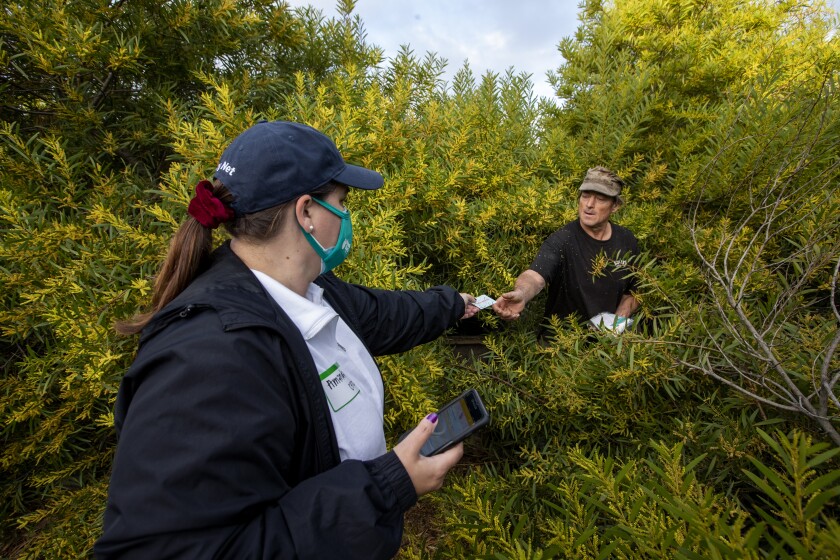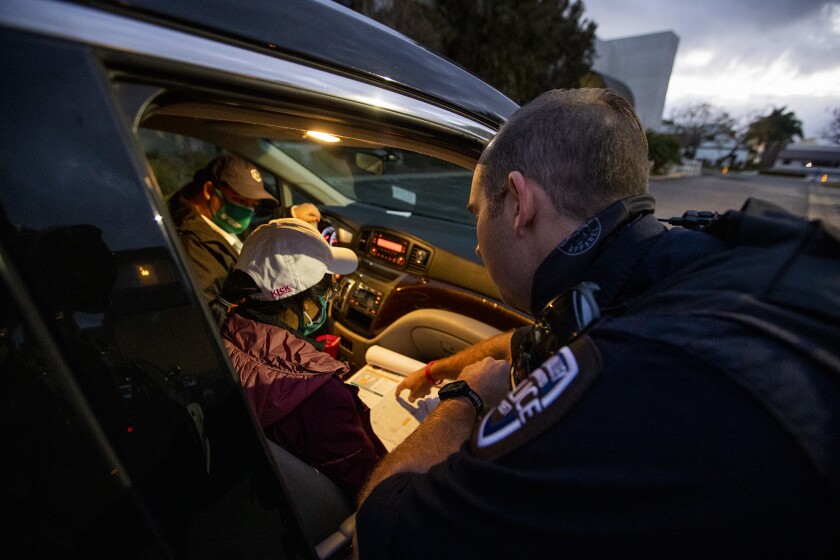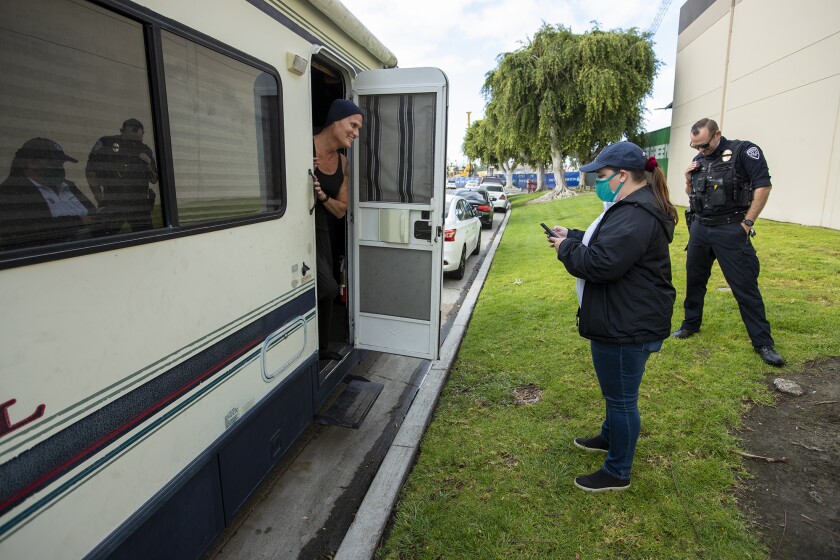Ad vocates and nonprofit leaders question the accuracy of Orange County homeless count
vocates and nonprofit leaders question the accuracy of Orange County homeless count

Some advocates and nonprofit leaders in Orange County are concerned that recent data showing a decrease in the number of homeless people in the county may be inaccurate and provide a misleading picture of the countywide housing crisis.
The concerns are being raised just weeks after the county announced that the 2022 Point in Time count revealed that the number of homeless people in Orange County has reduced by about 17% over the last three years, from 6,860 to 5,718 homeless people. County officials were quick to praise the results during a press conference last month, though they acknowledged that more work needs to be done.
Housing is a Human Right OC, a housing advocacy group, is using its #BeHonest campaign to spread awareness about its concerns regarding the homeless count and to urge the county Board of Supervisors to “be honest” about the validity of the concerns. The group is also seeking a commitment from the board to devote more funds to permanent housing and explore potentially using a housing bond to fund affordable housing.
Maura Mikulec, a member of Housing is a Human Right OC, said this year’s count had about 16% fewer volunteers than in 2019. Mikulec also said volunteers were directed to “hot spots” to survey homeless people, but that tactic likely left many individuals uncounted.
Mikulec said that even when the Point in Time count is carried out in a strategic manner, it provides an inaccurate picture of homelessness in the county because it merely provides a figure of the amount of homeless people at a given point in time. She pointed to the revelation that CalOptima — a county health organization that serves the medical needs of the poor and homeless — counted about 10,000 homeless people in the county in 2019, about 3,000 more than the Point in Time count.
The Point in Time count is a federally required biennial census that takes place over four days, three of which are devoted to counting unsheltered homeless people.
“The Point in Time count is a huge undercount, the methodology just really isn’t giving us a true count,” she said.

Due to the perceived inaccuracy of the count, the group is proposing as part of its campaign for the county to adopt a “by-name” homeless count list instead of the Point in Time count. Mikulec said the list would allow the county to keep better track of who has been housed, who has stayed housed and who hasn’t.
The by-name list is a tool developed by the nonprofit Community Solutions as a part of its Built for Zero movement, which seeks to help communities solve their local homelessness crises. According to the group, more than 100 communities are enrolled in the program, including the city and county of San Diego.
The group contends that a by-name list is “updated more regularly to provide communities with more actionable information on homelessness.”
“Using the point in time count methodology is like taking a photo with an early model camera,” the group’s website says. “The picture is distorted if the subject moves, and homelessness is always in flux, and the picture takes time to develop, in this case many months. The result is a hazy picture of the past.”
Doug Becht, director of the county’s Office of Care Coordination, said in an emailed comment that the 2022 Point in Time count was conducted with the same methods as the 2019 count, including the method in which the volunteers were deployed.
“More than 400 maps were created to assist volunteers/surveyors in canvasing and surveying the entire geographic area of Orange County,” Becht said. “As was done leading up to the Count in 2019, the County of Orange worked with City Net, homeless outreach providers, local law enforcement and city partners to help identify hot spots in each map that surveyors were likely to engage people experiencing homelessness.
“The training that was provided to all surveyors instructed each team to canvas the entire geographic area assigned to them, as well as the hotspots pre-identified on each map. Additionally, the use of the Survey123, an ARCGIS smart phone application, provided the County and Project Lead — City Net — the ability to see where surveys were being conducted in real time, allowing City Net to re-deploy to any location that appeared to potentially be under surveyed.”

Leaders of local nonprofits that provide homeless services also said that the Point in Time count has deficiencies when it comes to counting specific populations.
Kendra Puryear, chief development officer with the Orangewood Foundation, said over the phone that transition-aged youth between 16 and 25 years old are difficult to count because they experience homelessness in different ways. The Orangewood Foundation helps homeless youth in the county.
Many transition-aged youth who are homeless have temporary arrangements, possibly staying with friends or family, that aren’t captured by the Point in Time count.
“Many of them end up couch-surfing with friends, but this may not be a long-term arrangement,” Puryear said. “We work with quite a few youth who are coming out of the foster care system, and what we often see is some of those youth, if they have no other options, will go back to live with family or relatives where they may not really be safe or secure, or have real stable housing.
“I think the Point in Time, we certainly have wonderful things to say about it. I think it’s a wonderful effort to make sure that everyone’s counted and nobody is invisible, but it’s limited … Like others in the community, [transition-aged youth] could be using a motel voucher that night, they could be on a friend’s couch that night, if they have a vehicle or a friend has a van, they may be sleeping in the van.”
Nikki Buckstead, executive director of Family Solutions Collaborative, said it can be difficult to get an accurate count of homeless families with the Point in Time count because it tends to rely on maps that specify where homeless encampments are located. However, families don’t often stay in encampments. Buckstead said homeless families can stay in their vehicles, sheds or storage units.
“Homeless families are really good at being invisible,” she said. “They’re very resourceful. They don’t want to be seen. They want to make sure that their children are safe, and sometimes encampments aren’t the safest place for anyone to be in … So if the volunteers are being deployed to where the encampments are, there’s going to be a huge opportunity for families to get missed.”
LaVal Brewer, president and chief executive of South County Outreach, said that because the county’s homeless count is just a moment in time, families could be missed because they could be sleeping in cars or they’re unable to report to the area where the count is occurring. Buckstead said that homeless families were asked to come to a location to report themselves for the Point in Time count. However, that can be challenging for families who don’t have a car, and if they do have a vehicle, gas prices are a deterrence. Buckstead also said that many homeless families work, so they’re not going to be able to take time off to report in for the count.
“There’s kind of this inequity in terms of individual people going out to seek the individuals, yet asking families to come in and be counted,” Buckstead said.

This isn’t the first time the Family Solutions Collaborative has been concerned about the underrepresentation of families in the count. In 2017, the group held a Family Awareness Week due to the lack of families included in the count in previous years.
Getting an accurate accounting of the number of homeless people in Orange County can be crucial for attaining adequate funding from the federal government for homeless services. Buckstead said that the numbers are reported back to the U.S. Department of Housing and Urban Development, which allocates funds based on the data. Brewer said if organizations like his don’t get as much money from HUD, they will need to rely on more community support.
“So when sub-populations are underrepresented in the count, that’s a challenge because HUD looks at those numbers and says, ‘Oh, well, there’s not many homeless families in Orange County, so we’re not going to provide them with as much funding coming from the federal government,’” Buckstead said.
Mikulec said she’s concerned that the lack of an accurate count could cause county supervisors to not be as motivated about solving the crisis.
“Honestly, I don’t even know if the supervisors, who have a lot of power, I don’t know if they truly know the realities of homelessness,” she said. “And when you have a count like that, telling them that we’re moving in the right direction, they’re not going to be motivated to step it up.”




